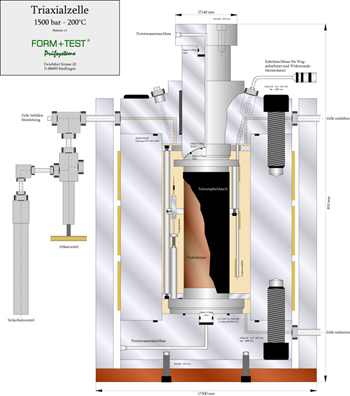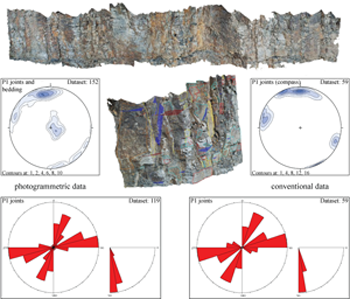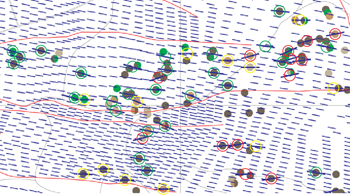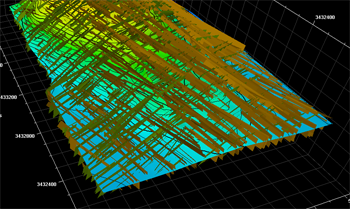
Rock mechanics
 Deformation tests provide the specific material parameters for the reservoir-scale geomechanical models. Using cylindrical samples of different lithologies encountered in the reservoir various uniaxial and triaxial tests are performed to determine specific rock properties like uniaxial compressive strenght (UCS), Young´s modulus, Poisson ratio, cohesion and angle of internal friction.
Deformation tests provide the specific material parameters for the reservoir-scale geomechanical models. Using cylindrical samples of different lithologies encountered in the reservoir various uniaxial and triaxial tests are performed to determine specific rock properties like uniaxial compressive strenght (UCS), Young´s modulus, Poisson ratio, cohesion and angle of internal friction.
Photogrammetry
 The documentation of fracture patterns can be supplemented by photogrammetric studies which allow for a rapid and reliable determination of fracture characteristics. I used the Siroviosion software of CSIRO Exploration and Mining, which utilizes stereographic images to create an accurate 3D image which then can be interpreted either manually or automatically. Larger ourcrop sections can be analysed by merging various 3D images (mosaic).
The documentation of fracture patterns can be supplemented by photogrammetric studies which allow for a rapid and reliable determination of fracture characteristics. I used the Siroviosion software of CSIRO Exploration and Mining, which utilizes stereographic images to create an accurate 3D image which then can be interpreted either manually or automatically. Larger ourcrop sections can be analysed by merging various 3D images (mosaic).
Finite element modeling
 Geomechanical reservoir models based on the FE-method are used to model the stress perturbations in relation to the fault systems (2D or 3D). Boundary conditions representing the regional stress field are applied to the sides of the model using displacements. Parameter studies help to assess the impact of different regional stress orientations onto the modeling results. This can be achieved by step-wise rotation of the outer model boundary (load frame) relative to the stable fault geometry in the model centre. Modeling results can be presented, among others, as stress trajectories showing the orientation of one of the principal stresses.
Geomechanical reservoir models based on the FE-method are used to model the stress perturbations in relation to the fault systems (2D or 3D). Boundary conditions representing the regional stress field are applied to the sides of the model using displacements. Parameter studies help to assess the impact of different regional stress orientations onto the modeling results. This can be achieved by step-wise rotation of the outer model boundary (load frame) relative to the stable fault geometry in the model centre. Modeling results can be presented, among others, as stress trajectories showing the orientation of one of the principal stresses.
Discrete fracture modeling
 For the optimal exploitation of a fractured reservoir a detailed documentation of the joint system and their spatial variability is of critical importance. A fundamental challenge exists in the extrapolation of fracture properties observed in wells to the kilometer-scale of the reservoir, in particular, as substantial local variations in fracture characteristics (orientation, type, density, etc.) can exist. Discrete fracture networks (DFN) models based on geostatistical assumptions are commonly used for this task.
For the optimal exploitation of a fractured reservoir a detailed documentation of the joint system and their spatial variability is of critical importance. A fundamental challenge exists in the extrapolation of fracture properties observed in wells to the kilometer-scale of the reservoir, in particular, as substantial local variations in fracture characteristics (orientation, type, density, etc.) can exist. Discrete fracture networks (DFN) models based on geostatistical assumptions are commonly used for this task.
 Rock mechanics
Rock mechanics Photogrammetry
Photogrammetry FE-modeling
FE-modeling DFN-modeling
DFN-modeling